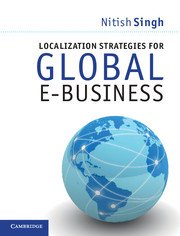Book contents
- Frontmatter
- Contents
- Figures
- Tables
- Preface
- Illustration credits and acknowledgements
- 1 Global e-commerce opportunities and challenges
- 2 International e-business expansion and market entry strategies
- 3 Global online consumer segmentation
- 4 Web globalization strategies
- 5 Developing international websites: internationalization
- 6 Effectively localizing international websites
- 7 Managing a web globalization value chain
- 8 Optimizing international websites
- 9 Assessing web globalization efforts
- 10 Strategic industry insights and emerging localization trends
- Web globalization resources
- Index
- References
8 - Optimizing international websites
Published online by Cambridge University Press: 05 June 2012
- Frontmatter
- Contents
- Figures
- Tables
- Preface
- Illustration credits and acknowledgements
- 1 Global e-commerce opportunities and challenges
- 2 International e-business expansion and market entry strategies
- 3 Global online consumer segmentation
- 4 Web globalization strategies
- 5 Developing international websites: internationalization
- 6 Effectively localizing international websites
- 7 Managing a web globalization value chain
- 8 Optimizing international websites
- 9 Assessing web globalization efforts
- 10 Strategic industry insights and emerging localization trends
- Web globalization resources
- Index
- References
Summary
Introduction
The optimization of international websites is the direct result of the proper management and implementation of the web globalization value chain. The required people, processes, capabilities, documents, and technologies must be managed in a way to allow the four primary activities of the web globalization value chain (see Chapter 7) to be undertaken in a collaborative and effective manner. A well-optimized international website is one that achieves the following:
international sites and pages are easy to find and navigate;
the site is easy to understand and loads quickly;
the site has a desirable user experience and flow;
Unicode is enabled to depict various languages seamlessly;
the site is locale-sensitive and culturally customized;
the site is well internationalized, allowing for adjustments to the user interface for language and locale requirements;
the site is well tested, in order to enhance its navigation, content, and functional quality;
the site achieves content synchronization, currency (i.e., it is up to date), and relevancy across multilingual websites for various countries;
the turnaround for deploying multilingual content is fast; and
multilingual search engine optimization is enabled by proper global content management.
- Type
- Chapter
- Information
- Localization Strategies for Global E-Business , pp. 213 - 243Publisher: Cambridge University PressPrint publication year: 2011



